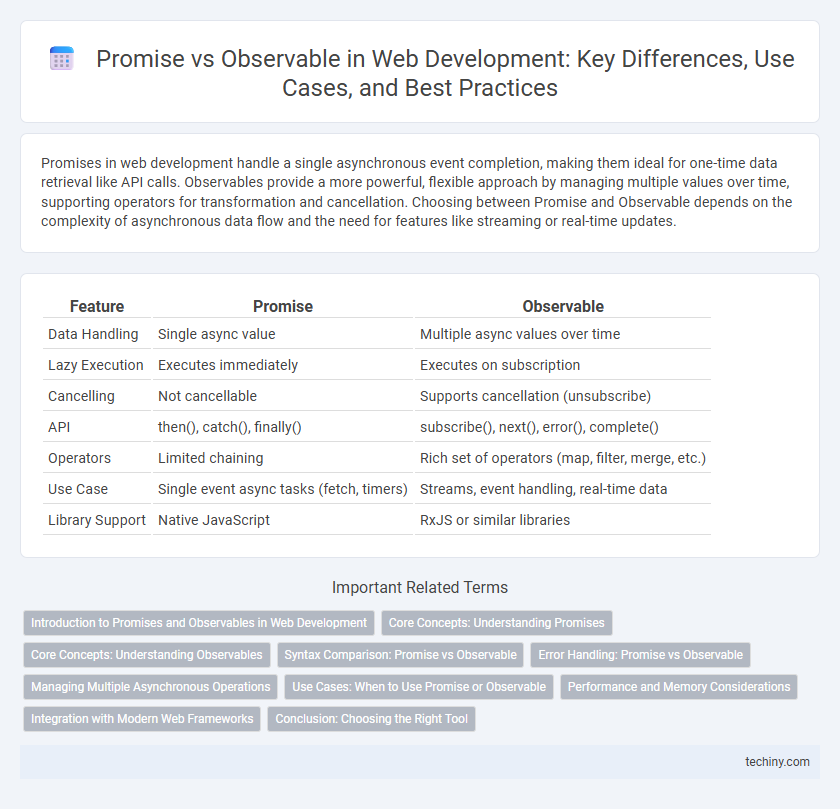Promises in web development handle a single asynchronous event completion, making them ideal for one-time data retrieval like API calls. Observables provide a more powerful, flexible approach by managing multiple values over time, supporting operators for transformation and cancellation. Choosing between Promise and Observable depends on the complexity of asynchronous data flow and the need for features like streaming or real-time updates.
Table of Comparison
| Feature | Promise | Observable |
|---|---|---|
| Data Handling | Single async value | Multiple async values over time |
| Lazy Execution | Executes immediately | Executes on subscription |
| Cancelling | Not cancellable | Supports cancellation (unsubscribe) |
| API | then(), catch(), finally() | subscribe(), next(), error(), complete() |
| Operators | Limited chaining | Rich set of operators (map, filter, merge, etc.) |
| Use Case | Single event async tasks (fetch, timers) | Streams, event handling, real-time data |
| Library Support | Native JavaScript | RxJS or similar libraries |
Introduction to Promises and Observables in Web Development
Promises in web development represent a single future value, enabling asynchronous operations to handle success or failure states through methods like .then() and .catch(). Observables provide a more powerful abstraction by supporting multiple asynchronous data streams over time, using operators for complex event handling and reactive programming patterns. Understanding the distinction between Promises and Observables is crucial for managing asynchronous events and data flows efficiently in modern JavaScript frameworks like Angular and React.
Core Concepts: Understanding Promises
Promises represent a single asynchronous operation that resolves with a value or rejects with an error, making them ideal for handling one-time events in web development. They encapsulate the eventual completion or failure of an asynchronous task and provide methods like then(), catch(), and finally() for chaining and error handling. Understanding Promises is essential for managing asynchronous code efficiently, especially when dealing with network requests or user interactions in modern JavaScript applications.
Core Concepts: Understanding Observables
Observables are lazy collections of multiple values over time, enabling reactive programming by emitting data streams that can be subscribed to and manipulated with operators. Unlike Promises that resolve once with a single value, Observables provide continuous data handling, cancellation support, and powerful composition capabilities essential for asynchronous event management in modern web development. Key methods such as subscribe(), next(), error(), and complete() facilitate granular control over data streams and error handling within frameworks like Angular and RxJS.
Syntax Comparison: Promise vs Observable
Promises use a simple syntax with `then()` and `catch()` methods to handle single asynchronous values, while Observables utilize the `subscribe()` method to manage streams of multiple values over time. Promises are eager and execute immediately upon creation, contrasted with Observables which are lazy and only start emitting data when subscribed. Syntax differences reflect their core functionalities: Promises handle one-time asynchronous operations, whereas Observables provide powerful operators for complex event handling and data transformation.
Error Handling: Promise vs Observable
Promises provide a single error handling pathway through the .catch() method, capturing one error event during asynchronous operations, which completes the flow after resolution or rejection. Observables offer more granular error management by allowing multiple error emissions over time, enabling developers to handle, recover, or retry errors dynamically within a stream using operators like catchError. This makes Observables more suitable for complex scenarios requiring continuous data streams and sophisticated error recovery strategies.
Managing Multiple Asynchronous Operations
Promises handle a single asynchronous operation and resolve once, making them suitable for straightforward tasks but less efficient for managing multiple ongoing events. Observables provide a powerful framework to manage multiple asynchronous data streams by supporting operators like merge, concat, and combineLatest, allowing developers to handle complex event sequences and real-time updates effectively. Leveraging Observables with libraries like RxJS enables scalable and composable solutions for concurrent asynchronous operations in modern web applications.
Use Cases: When to Use Promise or Observable
Promises excel in handling single asynchronous operations such as fetching data from an API or performing file-based tasks, where a one-time result is expected. Observables are ideal for scenarios involving multiple values over time, such as real-time data streams, user input events, or WebSocket communication. Choosing between Promise and Observable depends on the need for simplicity with single-value asynchronous processes or advanced features like cancellation, operators, and multi-value emissions typical in reactive programming.
Performance and Memory Considerations
Promises in web development offer a straightforward approach to handle single asynchronous events with minimal memory overhead, making them suitable for performance-critical tasks that require one-time responses. Observables provide a more powerful and flexible way to handle multiple asynchronous data streams, but their continuous subscription model can lead to increased memory consumption if not properly managed with operators like unsubscribe. Choosing Observables over Promises depends on the app's need for handling streams of events versus single asynchronous results, with careful attention to performance profiling and memory leak prevention strategies.
Integration with Modern Web Frameworks
Promises are natively supported in JavaScript, making them easily integrable with frameworks like React and Vue for handling single asynchronous operations. Observables, offered by libraries such as RxJS, provide enhanced capabilities for managing multiple or continuous data streams, fitting seamlessly into Angular's reactive programming model. Modern web frameworks favor Observables for complex event handling and real-time data updates, while Promises remain optimal for simpler, one-time async tasks.
Conclusion: Choosing the Right Tool
Promise offers a straightforward approach for handling single asynchronous operations with ease and simplicity, making it ideal for scenarios requiring one-time data retrieval. Observable provides greater flexibility with support for multiple values over time, cancellation, and operators for complex event handling, which suits real-time applications and streams. Selecting between Promise and Observable depends on the specific needs of the project, such as whether managing continuous data flows or a single asynchronous response is required.
Promise vs Observable Infographic

 techiny.com
techiny.com